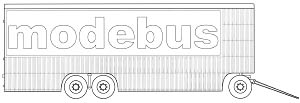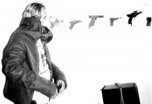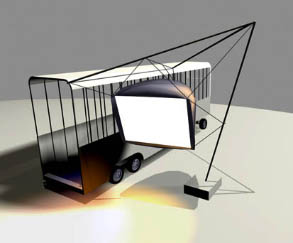
 |
|
 |
Do 5. bis So 8.August 1999 modebus am Alten Markt Salzburg 11:00 - 17:00 >mode visuell< 18:00 - 21:00 >time scann 1< 11:00 am Sa 7.August 1999: Gespräche - Kaffee - Kuchen mit Hildegard Fraueneder |
|
 |
 |
 foto: Bruno Stubenrauch |
>time scan 1< eine modebus-produktion Videothek im modebus mit Künstlerpositionen zum Themenkomplex Bekleidung/Styling/Mode mit Beiträgen von: Uli Aigner, Michael Blank, Hubert Blanz, Max Bühlmann, Zabo Chabiland, Tim Chu/Jinjule Kiku, Emanuel Daschner, Mario Grubisic, Mariela Guemisheva, Heidrun Holzfeind, Barbara Kaiser, Karl-Heinz Klopf, Sigrid Kurz, Elke Krystufek, Gülsün Karamustafa/Peter Spillmann/Marion von Osten, Pia Lanzinger, Raimundas Malasauskas, Dorit Margreiter, Sabine Marte, Muntean/Rosenblum, Isa Rosenberger, Fiona Rukschcio, David Rych, Johannes Schweiger, Frederike Schweizer, Uli Vonbank-Schedler, Eva Ursprung, Erwin Wurm, ZAPP Video-Magazin Konzept und Organisation: Ursula Graf Ein Artikel von Markus Mittringer im STANDARD vom 25.6.1999 über den Vortarag von Aoki Shoichi ist nachzulesen unter www.derstandard.at . |
| >mode visuell< eine modebus-produktion Das Thema der Wahrnehmung von Mode durch deren visuelle Reproduktion soll drei Tage lang zur Betrachtung stehen. Die Übersetzung vom realen Gegenstand in dessen Abbildung dient nicht nur der Information über neue Formen der Bekleidung, sondern vermittelt Bilder und Stimmungen, die mit diesen Kleidern einhergehen. Mode wird inszeniert und so zum spezifischen Ausdruck von Zeit, der den Betrachter leitet und es ihm ermöglicht, Entwicklungen mitzuvollziehen. Eine kritische Betrachtung des Mediums Modefotografie darf nicht hintan stehen. Was steht hinter der Konzeption einer "Geschichte"? In welchem Verhältnis stehen Mode und Medien? Mode ist selbst ein Medium, wozu wird es, wenn es herausgenommen aus seinem alltäglichen Wirkungsfeld, in einen inszenierten Rahmen gesetzt ist? Sowohl durch die Vorträge als auch durch die Infobox und durch Gespräche mit den Beteiligten, sollten sich diese Fragen erhellen. MITWIRKENDE: FotografInnen - modebus DesignerInnen Günter Parth - Ute Neuber York Weissmann - Nina Bernert Sissi Farassat - Ozzi Oswald Udo Titz - Eva Blut Lisa Holzer - Edwina Hörl Eva Blut: Konzept und Organisation Im RONDO, der Freitagsbeilage des Standard vom 9.7.1999 ist ein Beitragmit dem Titel "On the road again" der Veranstaltung >mode visuell< gewidmet. Nachzulesen unter: http://derstandard.at/Rondo090799/index.html |
 Videopneu von I.Ch. Schömitz |
INTERNATIONALE SOMMERAKADEMIE
|
Fashion Design First, a description of what MODEBUS understands by fashion in the post-modern
age. Fashion means taking into account current events and social conditions.
It is not so much a question of setting new trends as of taking a stand
on the general feeling of the time. A designer with awareness of this feeling
will observe the way everyday clothing is worn in the street. Fashion is
avisual language which at the end of the '90s is, like music, often communicated
by sampling and mixing. Samples from past times and other cultures and all
kinds of uniforms are combined to form something new. Playing around with
old codes and the significance of parts of garments becomes a game of style.
New possibilities arise through "unsuitable" combinations. The
designer is at once stylist and creator. The new form is either developed
with reference to what already exists, by calling it in question, by breaking
it up and reorganising it, by intensification, or discovered by three-dimensional
experiment, starting from zero, initially without a pattern. The paper pattern
serves merely to document the development; it is constructed from "snapshots"
of minor decisions on the design of the product, and later becomes the pattern
for the reproduction. The objective (the form) determines the means (the
technique of development).
INFO
LITERATUR
SPRACHEN |
| |
|
|||